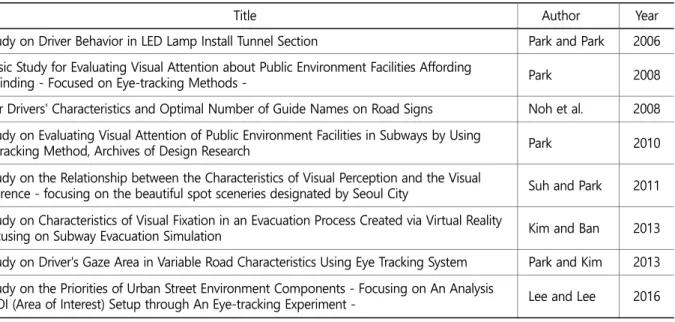JESK http://jesk.or.kr eISSN:2093-8462
A Review on the Application of Eye-tracking in Design Areas
Hee-Sok Park
Department of Industrial Engineering, Hongik University, Seoul, 04066
Corresponding Author Hee-Sok Park
Department of Industrial Engineering, Hongik University, Seoul, 04066 Mobile : +82-10-2389-1473 Email : hspark@hongik.ac.kr
Received : August 23, 2016 Revised : August 30, 2016 Accepted : September 19, 2016
Objective: This study aims to examine domestic literature on eye-tracking in the design area, and to present new eye-tracking application directions.
Background: Eye-tracking was introduced in the experimental psychology field for the first time in the 1950s. Eye-tracking has high utilization values in the design application area because eye-tracking can accumulate data on what people see, providing the quantitative values on eye movement.
Method: This study examined the papers published in domestic journals, as well as the papers presented in conferences from 2000 to 2016 through DBPIA.
Results: Although the use of eye-tracking technology was slightly meager in the product design area, it has been actively used for the evaluation analyses of preference and attention in architecture/public design. Eye-tracking also presented a method to design advertisement that is helpful to advertisement effect measurement, and product salesin the advertisement design area. Since detail psychological analysis is possible, the application of eye-tracking in the studies related with user interface has been active.
Conclusion: The eye-tracking technology is projected to be actively used as a new interface means, such as in helping in disabled people's communication and in device control, in addition to conventional application areas.
Application: This study would be of help to find future research areas of eye-tracking.
Keywords: Eye-tracking, Design, Review
Copyright@2016 by Ergonomics Society of Korea. All right reserved.
○
ccThis is an open-access article distributed under the terms of the Creative Commons Attribution Non-Commercial License (http://creativecommons.org/licenses/by-nc/3.0/), which permits unrestricted non-commercial use, distribution, and reproduction in any medium, provided the original work is properly cited.


